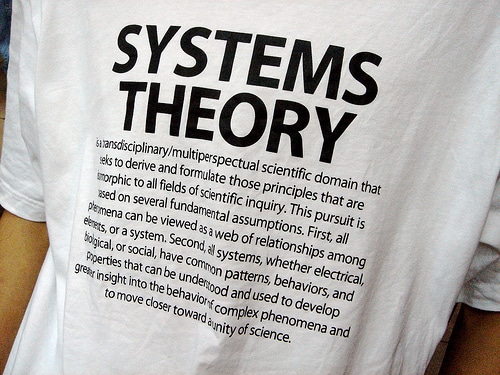The Formula That Predicts Success or Failure
Summary Insight:
Every system fails or thrives based on one thing: how well it manages energy. Learn to spot and stop entropy before it kills your business, health, or momentum.
Key Takeaways:
- Success = Integration ÷ Entropy. Master the formula.
- Energy always flows first to manage internal friction—what’s left drives growth.
- Ignore entropy and your system fails, no matter the strategy.
If you want to understand how something really works and what makes it successful, it’s not enough to break it down into its individual components. Instead, you need to look at how it operates as a system. By definition, a system is a series of interacting, interrelated, or interdependent elements forming a complex whole. And there’s absolutely nothing you can think of that is not a system. For example, you’re a system (specifically, a complex adaptive or living system). You have a body, which is a physical system comprised of other systems (immune, circulatory, digestive, etc.). If we were to look closely at any one of these, we’d see that they’re comprised of even smaller systems. And of course, your physical system is also an element in a larger system. You have a mental and an emotional system; you’re part of a family system, a community system, an economic system, a government system, an ecological and planetary system, and so on. Everything is a system.
When it comes to the study of what makes something successful, what we’re really asking is what causes a complex adaptive system to fail or succeed. Success simply means that the system (e.g., you, your family, your company, or whatever you choose to identify as the system) attains a desired goal. Failure means it does not. Winning the Super Bowl…being happy…earning a billion dollars – as long as you can measure it quantitatively or qualitatively, it’s a valid definition of success. And because everything, large or small, is a system, we can use the same universal principles to understand if it’s likely to fail or succeed. That’s pretty cool.
What actually does cause any system to fail or succeed? The answer is System Energy Management. This means just what it sounds like: System Energy Management defines how energy behaves within a system.
The Universal Success Formula

The first law of thermodynamics is called “Conservation”. It tells us that, at any given point in time, the potential energy available to a system is finite. Whether we’re referring to your family or your business, this has a finite amount of potential energy available to it. In order to get new energy, the system must acquire it from the surrounding environment — just like you must get food from the refrigerator or your business must get sales from its customers.
The second law of thermodynamics is called “Entropy”. It tells us that every system falls apart over time. No matter how hard we try, there’s no escaping the irresistible force of entropy. You, me, and everything in the universe are ultimately falling apart over time due to entropy. Aging, disintegration, deterioration, and disorder are all synonyms for entropy. It is constantly eating away at a system from the inside.
To understand how the laws of thermodynamics fit into organizational theory, then, just remember that every system has a finite amount of potential energy and every system is falling apart over time. Simple. (If you’d like to learn more about the underlying physics involved in success, you can read more at the end of this post). Now that you know these two laws, you can begin to use them to understand if your organization or any other system in the universe (including you, your family, your community, your company, and your favorite sports team) is likely to fail or succeed. You do that by understanding the universal success formula:

The universal success formula shows that success is just a function of two things: integration over entropy. Let’s define the terms and then explain how this works. As you already know, success is any goal you desire to attain: making a lot of money, falling in love, being fit and healthy, raising a family, growing your business, or even winning the Super Bowl. It doesn’t matter how you define it.
Integration is a measure of how much energy the system is getting from its environment. Energy in this case is anything useful and desirable that can be made productive in the pursuit of success (e.g. money, resources, clout, etc.). High integration is good. Low integration is bad. Why? Because when there’s high integration between a system and its environment, the system has aligned its capabilities with opportunities and is extracting available energy. It can use this energy to be successful. If there’s no integration, then there’s no new energy available to the system and it will fail. To learn more about integration, capabilities, and opportunities, read The Goal of Any Strategy.
Entropy in the formula indicates the amount of energy required to maintain the system, make decisions, and get work done. Low entropy is good. High entropy is bad. Why? We know from the first law of thermodynamics that, at any given point in time, the potential amount of energy available to a system is finite. We also know from the second law of thermodynamics that the force of entropy is constantly eating away at a system. And here’s where it gets profound: The energy available to a system must always flow first to manage its entropy needs. Only after those needs are met, and if any energy if left over, it will be made available for integration. Therefore, the higher the level of entropy, the lower the level of success. And if entropy gets too high, the system will perish and fail.

Be Aware of Entropy in the System
The fact that available energy first flows to manage a system’s internal entropy needs is a universal law – it applies to all systems, big or small. Let’s take a look at some everyday examples to see how prevalent this law is in your everyday experience.

Similarly, if you’ve ever had a bad back, you know how hard it is to work at your usual level of productivity, creativity, and effectiveness. This is yet another entropy problem! Entropy is the reason we say “health is the most important thing” and “if you lose your health, you lose everything.” Energy flows from inside a system outward. If your health goes, the entropic requirements of your system make it very hard for you to be successful out in the world.


If you’ve ever felt hurt, angry, or betrayed in your work (and who hasn’t), then you know that these emotions leave you with less energy, zeal, and awareness to bring to your job. Yet another entropy problem! Your mental and emotional states are systems that are subjected to the laws of thermodynamics. When your mind and emotions are sucking energy, the system needs more energy to maintain itself and there will be less energy available for you to be engaged and productive.
Imagine a company with a growing opportunity in the marketplace and with the unique capabilities to exploit it but whose co-founders are at each other’s throats. There’s mistrust and a lack of respect that impact how sales, marketing, finance, and technology plan, communicate, and work together. This is an entropy problem. It costs too much energy to maintain the system against this onslaught and the company won’t be able to marshal its resources effectively to capture the opportunity. Unless the current energy drains can be freed up, the company will succumb to entropy and perish (specifically, the company loses its ability to integrate – i.e. make sales, meet customer needs, and adapt to changing conditions in the market – because the internal friction is too high).


The Key to a Thriving Business
Now that you’re familiar with some signs of entropy in everyday life, you’ll be able to better understand its negative impact on your business. For example, imagine that your company has 100 arbitrary points of energy and that 50 of them are needed to maintain the system, make decisions, and get work done. This would leave 50 points available to do integration – in other words, to find opportunities, build your capabilities, make sales, and so on. In this case, be wary. Ignore entropy at your peril.
Now imagine that you’re able to decrease your internal energy needs by half, to 25 points. That leaves 75 points available for integration. This is a 300% improvement in your top-line performance. You now have that much more energy to integrate new opportunities, develop new capabilities, make sales, etc. This is awesome.
One question I’m often asked about the application of the laws of thermodynamics to business in this: “Is my company’s available energy really fixed? Can’t I go out and raise more capital, get a new sale, complete a merger or acquisition, etc. and thus increase my available energy?” The answer is yes, you can – and only as long as the amount of energy needed to keep entropy in check is less than the amount of new energy you can get from the environment. There’s an old adage in business that says: “I’ve never seen a problem big enough that another sale can’s solve!” This is true as long as the revenue from sales is more than the expenses the business must bear. Your goal isn’t to eliminate entropy completely (you can’t). Your goal is to keep integration higher than entropy. The bigger the spread, the more potential for success your business has.
Keep in mind that when an organization has a high amount of internal entropy but temporarily gets more energy through sales, raising capital, or acquiring another company, this usually only compounds the underlying problems. If you’ve ever been part of a bad merger or acquisition, you’ll know what I mean. Trying to bypass internal entropy needs is like trying to cure an illness by masking the symptoms with medication. Yes, it can feel better – but if the underlying condition is still there, you’ve got a bigger lingering problem destroying the system from within. For example, when you’re tired (entropy) at work, you go and get a cup of coffee. This is a temporary stimulant to get you through the day. However, if you keep going for coffee again and again, the internal entropy needs are simply being masked, not solved. Ultimately, the acidity eats away at your health and your doctor recommends you quit the coffee, take up herbal tea, and get more rest and exercise to better manage your stress. Similarly, if you can solve the underlying conditions that are causing entropy to increase in your business, you’ll roll more energy to the bottom line and have a stronger, more resilient, and high-performing organization.
Life Can Be Hard But It’s Still Pretty Awesome
 We each have a finite amount of time and energy to perform integration within our lives, to understand ourselves and others, and to experience the fullness that life has to offer. The inexorable pull of entropy, dissolution, and ultimately death is always present in the background. Even so, we are evolving beings with an impulse to create, integrate, and thrive. When we manage the dynamic between entropy and integration with awareness and the right balance – that’s when we meet our potential to be successful beyond expectation.
We each have a finite amount of time and energy to perform integration within our lives, to understand ourselves and others, and to experience the fullness that life has to offer. The inexorable pull of entropy, dissolution, and ultimately death is always present in the background. Even so, we are evolving beings with an impulse to create, integrate, and thrive. When we manage the dynamic between entropy and integration with awareness and the right balance – that’s when we meet our potential to be successful beyond expectation.
Back to the The Physics of Success & Happiness Guide.
Next to Where Are Your Energy Drains?
About the Physics
For those of you who are interested in (or perhaps questioning) how the laws of thermodynamics actually dictate the success or failure of complex adaptive systems, I’m including more detail below.
Entropy in Open vs. Closed Systems
In physics, there are two basic classifications of systems, closed and open. A closed system is one that can exchange energy (heat and work), but not matter, with its surroundings, while an “open” system exchanges matter and energy with its surroundings. In the 1800s, when the word “thermodynamics” was first coined, it was thought that the laws of thermodynamics only applied to closed or isolated systems.
We now know that no system is really closed or isolated (other than the summation of all systems that we call the universe or multiverse). This is because energy and matter are really the same thing and with any attempt to define matter as a particle, we find that it resembles a wave or a new definition of matter such as quark–gluon plasma. Notice, too, that the more you try to define where one system begins and the other ends, the less you’ll be able to identify a boundary. It’s as if someone asked you to measure the coastline of California. How long is it? Well, the more closely you attempt to measure it, the longer it gets. Not only is everything a system, but everything is an open system in interaction with the rest. Even a vacuum in space is teeming with energy and information and in open exchange with other systems.
As it turns out, how we apply the laws of thermodynamics (energy first flows to manage internal needs and only what’s left can be used for integration) applies well to organizations of any size and is equally valid for all systems, closed and open.
The founder of General Systems Theory, Bertrand von Bertanlanffy, wrote about the contrast of entropy between open and closed systems, explaining that, “…on the basis of the theory of open systems, the apparent contradiction between entropy and evolution disappears. In all irreversible processes, entropy must increase. Therefore, the change of entropy in closed systems is always positive; order is continually destroyed. In open systems, however, we have not only production of entropy due to irreversible processes, but also import of entropy which may well be negative. This is the case in the living organism which imports complex molecules high in free energy. Thus, living systems, maintaining themselves in a steady state, can avoid the increase of entropy, and may even develop towards states of increased order and organization.”1
At the same time, Von Bertanlanffy recognized that, beyond the dynamic between entropy and integration (“… the violent contradiction between Lord Kelvin’s degradation and Darwin’s evolution, between the law of dissipation in physics and the law of evolution in biology”), according to the second principle of thermodynamics, the general trend of events in physical nature is towards states of maximum disorder and leveling down of differences, with the […] heat death of the universe as the final outlook, when all energy is degraded into evenly distributed heat of low temperature, and the world process comes to a stop.”2
What is “Energy?”
In classic physics, energy represents the ability to do work or to exert pulls or pushes on a physical object against the basic forces of nature like gravity and along a path of a certain length. In Organizational Physics, “energy” means any source of usable power. This includes not only the ability to exert a change on a physical object but also on an entire organization. It also includes energy equivalents such as money, resources, and clout. “Money” is really just a form of stored value or energy. It’s used to make the exchange of products and services (other forms of stored energy) more efficient. “Resources” includes power sources that the organization has available to itself, including the stored energy potential of the people, materials, natural resources, know-how, and capital equipment involved. “Clout” is the influence and good will that the organization has built up over time. From a business and personal perspective, if you think of energy as anything useful and desirable that can be made productive in the pursuit of success, you have a good working definition.
1. Ludwig von Bertalanffy, General Systems Theory, Braziller, 2003.
2. Ibid.






